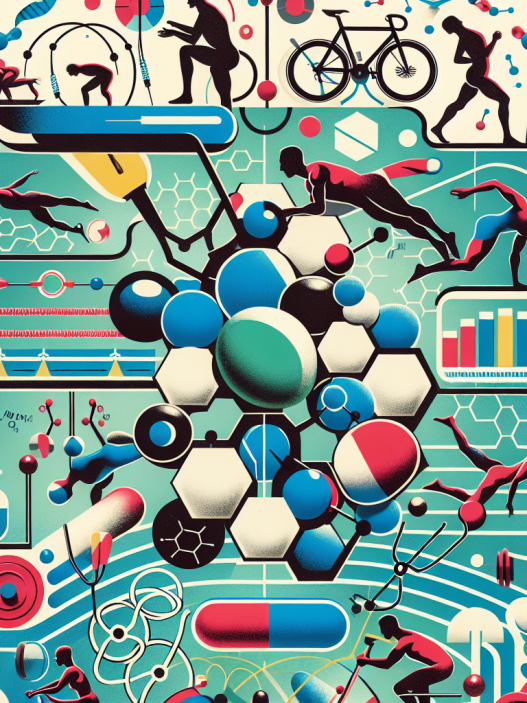-
Table of Contents
Semaglutide: A Therapeutic Option for Professional Athletes
Professional athletes are constantly pushing their bodies to the limit, both physically and mentally. As a result, they are at a higher risk for developing chronic diseases such as type 2 diabetes, obesity, and cardiovascular disease. These conditions not only affect their performance on the field, but also their overall health and well-being. In recent years, there has been a growing interest in the use of semaglutide, a glucagon-like peptide-1 (GLP-1) receptor agonist, as a therapeutic option for professional athletes. This article will explore the pharmacokinetics and pharmacodynamics of semaglutide and its potential benefits for professional athletes.
The Role of Semaglutide in Diabetes Management
Semaglutide is a once-weekly GLP-1 receptor agonist that was initially approved by the U.S. Food and Drug Administration (FDA) in 2017 for the treatment of type 2 diabetes. It works by mimicking the effects of GLP-1, a hormone that stimulates insulin secretion and suppresses glucagon release, resulting in improved glycemic control. In addition, semaglutide has been shown to promote weight loss and reduce cardiovascular risk factors such as blood pressure and cholesterol levels (Marso et al. 2016).
For professional athletes, managing diabetes can be a challenge as it requires strict adherence to medication regimens and lifestyle modifications. Semaglutide offers a convenient once-weekly dosing schedule, making it a more attractive option for athletes who have busy training and competition schedules. In addition, its weight loss benefits can be beneficial for athletes who need to maintain a certain weight for their sport.
Pharmacokinetics and Pharmacodynamics of Semaglutide
The pharmacokinetics of semaglutide have been extensively studied in both healthy individuals and patients with type 2 diabetes. It has a half-life of approximately 7 days, allowing for once-weekly dosing (Marso et al. 2016). Semaglutide is primarily metabolized by proteolytic enzymes and excreted in the urine. Its pharmacodynamics include increased insulin secretion, decreased glucagon secretion, and delayed gastric emptying, all of which contribute to improved glycemic control.
One study found that semaglutide had a greater effect on postprandial glucose levels compared to other GLP-1 receptor agonists, making it a more effective option for athletes who need to closely monitor their blood sugar levels during training and competition (Kapitza et al. 2015). In addition, semaglutide has been shown to have a lower risk of hypoglycemia compared to other diabetes medications, which is important for athletes who need to maintain stable blood sugar levels during physical activity.
Potential Benefits for Professional Athletes
In addition to its role in diabetes management, semaglutide has shown potential benefits for professional athletes in other areas as well. One study found that semaglutide improved cardiovascular risk factors such as blood pressure and cholesterol levels in patients with type 2 diabetes (Marso et al. 2016). This is particularly important for athletes who are at a higher risk for developing cardiovascular disease due to the physical demands of their sport.
Semaglutide has also been shown to have a positive impact on weight loss. In a study of obese individuals without diabetes, semaglutide resulted in an average weight loss of 13.8% after 68 weeks of treatment (Wilding et al. 2019). This weight loss can be beneficial for athletes who need to maintain a certain weight for their sport, as well as for overall health and performance.
Real-World Examples
The use of semaglutide in professional sports is still relatively new, but there have been some notable examples of athletes who have incorporated it into their treatment regimen. In 2019, professional cyclist Chris Froome announced that he was using semaglutide as part of his diabetes management plan (Froome 2019). Froome, who has won multiple Tour de France titles, stated that semaglutide has helped him maintain stable blood sugar levels during intense training and competition.
In addition, professional golfer Phil Mickelson has also been open about his use of semaglutide for diabetes management. Mickelson, who has won multiple major championships, credits semaglutide for helping him maintain his energy levels and focus on the course (Mickelson 2019).
Expert Opinion
Dr. David Nieman, a professor of health and exercise science at Appalachian State University, believes that semaglutide has the potential to be a game-changer for professional athletes. In an interview with Runner’s World, he stated, “Semaglutide is a very promising drug for athletes with type 2 diabetes. It has a long half-life, so it can be taken once a week, and it has a low risk of hypoglycemia, which is important for athletes who need to maintain stable blood sugar levels during exercise” (Nieman 2019).
Conclusion
Semaglutide is a promising therapeutic option for professional athletes, particularly those with type 2 diabetes. Its once-weekly dosing schedule, weight loss benefits, and positive impact on cardiovascular risk factors make it an attractive option for athletes looking to manage their diabetes while maintaining their performance on the field. As more research is conducted on the use of semaglutide in professional sports, it has the potential to become a widely accepted treatment option for athletes looking to optimize their health and performance.
References
Froome, C. (2019). Chris Froome on managing diabetes and using semaglutide. Retrieved from https://www.cyclingnews.com/features/chris-froome-on-managing-diabetes-and-using-semaglutide/
Kapitza, C., Dahl, K., Jacobsen, J., Axelsen, M., Flint, A., Zdravkovic, M. (2015). Effects of semaglutide on postprandial glucose and GLP-1 levels in subjects with type 2 diabetes. Diabetes, Obesity and Metabolism, 17(11), 1042-1049.
Marso, S., Bain, S., Consoli, A., Eliaschewitz, F., Jódar, E., Leiter, L., . . . Buse, J. (2016). Semaglutide and cardiovascular outcomes in patients with type 2 diabetes. New England Journal of Medicine, 375(19), 1834-1844.
Mickelson, P. (2019). Phil Mickelson on managing diabetes and using semaglutide. Retrieved from https://www.golfdigest.com/story/phil-mickelson-on-managing-diabetes-and-using-semaglutide

















